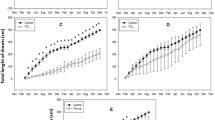Abstract
A procedure was developed to reduce premature bolting and flowering in Chinese cabbage grown in the field during the winter. This involved (a) the use of geothermic water as an inexpensive heat source for heating the transplants in the nursery; (b) application of the growth retardants daminozide (Alar) and paclobutrazol (PP333) to the heated plants before removing them to the field; and (c) application of daminozide to the plants in the field. This procedure markedly reduced stem elongation and the length of the internal stem in relation to the head without affecting the size of the head. Furthermore, application of daminozide in the field minimized the severity of tipburn, a common physiological disorder in Chinese cabbage fields. The result of such treatment was the production of high-quality Chinese cabbage heads which otherwise are unobtainable during the winter.
Similar content being viewed by others
References
Cox EF, McKee JMT and Dearman AS (1976) The effect of growth rate on tipburn occurrence in lettuce. J hort Sci 51:297–309
Dicks JW (1979) Modes of action of growth retardants. Joint Sci/BPGRG Monograph 4:1–25
Eguchi T, Matsumara T and Koyama T (1963). The effect of low temperature on flower and seed formation in Japanese radish and Chinese cabbage. Proc Am Soc hort Sci 82:322–331
Elers B and Wiebe HJ (1984a) Flower formation of Chinese cabbage. I. Response to vernalization and photoperiods. Scient Hort 22:219–231
Elers B and Wiebe HJ (1984b) Flower formation of Chinese cabbage. II. Antivernal-ization and short day treatment. Scient Hort 22:327–332
Lorenz OA (1946) Response of Chinese cabbage to temperature and photoperiod. Proc Am Soc hort Sci. 47:309–319
Napp-Zinn K (1961) Vernalisation und verwandte Erscheinungen. In: Handbuch der Pflanzenphysiologie XVI, pp 24–75 Berlin: Springer-Verlag
Pressman E (1979) Comparative physiology of wild and cultivated varieties of Apium graveolens L. with special reference to flowering. PhD Thesis, The Hebrew University of Jerusalem, Jerusalem. (Hebrew, with English summary)
Pressman E, Aviram H and Shaked R (1983) Inhibition of bolting in Chinese cabbage. Hassadeh 64:66–68 (in Hebrew)
Pressman E and Negbi M (1981) Bolting and flowering of vernalized Brassica pekinensis as affected by root temperature. J exp Bot 32:821–825
Sachs RM (1965) Stem elongation. A Rev Pl Physiol 16:73–96
Author information
Authors and Affiliations
Additional information
Contribution from the Agricultural Research Organization, The volcani Center, Bet Dagan, Israel. No. 1172-E, 1984 series.
Rights and permissions
About this article
Cite this article
Pressman, E., Aviram, H. Inhibition of flowering in Chinese cabbage by applying heat and growth retardants to transplants. Plant Growth Regul 4, 87–94 (1986). https://doi.org/10.1007/BF00025353
Received:
Revised:
Accepted:
Issue Date:
DOI: https://doi.org/10.1007/BF00025353




